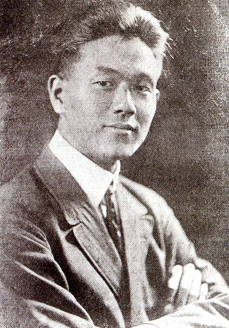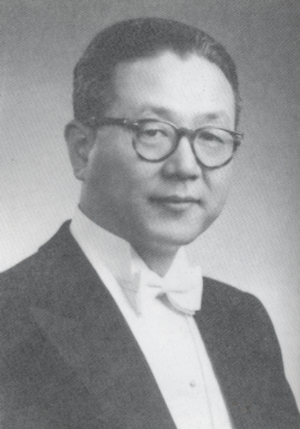Chang Myon facts for kids
Quick facts for kids
Chang Myon
|
|
|---|---|
|
장면
張勉 |
|
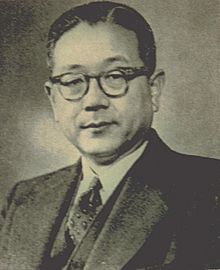 |
|
| 2nd Prime Minister of South Korea | |
| In office August 18, 1960 – May 18, 1961 |
|
| President | Yun Posun |
| Preceded by | Ho Chong |
| Succeeded by | Chang Do-yong |
| In office November 23, 1950 – April 24, 1952 |
|
| President | Syngman Rhee |
| Preceded by | Shin Song-mo |
| Succeeded by | Ho Chong (Acting) |
| 4th Vice President of South Korea | |
| In office May 30, 1956 – April 24, 1960 |
|
| President | Syngman Rhee |
| Preceded by | Ham Tae-young |
| Succeeded by | Office abolished |
| Personal details | |
| Born | August 28, 1899 Jeokseon-dong, Jongno-gu, Seoul, Korean Empire |
| Died | June 4, 1966 (aged 66) Myeongryun-dong, Jongno-gu, Seoul, South Korea |
| Political party | Democratic Party |
| Spouse | Kim Ok-yun |
| Children | 9, including Chang Yik |
| Alma mater | Manhattan College |
| Signature | |
| Korean name | |
| Hangul | |
| Hanja | |
| Revised Romanization | Jang Myeon |
| McCune–Reischauer | Chang Myŏn |
| Art name | |
| Hangul | |
| Hanja | |
| Revised Romanization | Unseok |
| McCune–Reischauer | Unsŏk |
Chang Myon (born August 28, 1899 – died June 4, 1966) was an important leader in South Korea. He was a teacher, a diplomat, a journalist, and a social activist. He also worked with Catholic youth groups.
Chang Myon was the only prime minister of the Second Republic, which used a parliamentary system. This means the prime minister, not the president, had the most power. He also served as the fourth and last vice president of South Korea during the First Republic. His special nickname was Unseok. His English name was John Chang Myon.
During the time Korea was ruled by Japan, Chang Myon worked in schools as a teacher and principal. In 1948, he led South Korea's group to the UN General Assembly. The next year, he became the first ambassador from South Korea to the United States.
In 1950, he helped convince the United States and the UN to send troops to help South Korea during the Korean War. He became the second prime minister of the First Republic of Korea in November 1950. From 1956 to 1960, he was the fourth vice president.
When Syngman Rhee's government was removed by the student protests in 1960, Chang Myon was chosen as the Prime Minister of the Second Republic. This government used a parliamentary system to prevent one person from having too much power. Chang Myon's time as prime minister ended when Park Chung-hee led a military takeover on May 16, 1961. This coup ended the Second Republic and South Korea's only time with a parliamentary government.
Contents
Life Story
Early Years
Chang Myon was born in 1899 in Jeokseon-dong, which is now part of Seoul. He was the first son of Chang Gi-bin and Lucia Hwang. His father worked as a customs officer in Incheon and later in Busan.
Chang Myon's family was part of the Indong Jang clan. His great-grandmother was the first in his family to become a Roman Catholic.
In 1906, he started school at Incheon Parkmun Primary School and finished in 1912. He then went to Incheon Public Simsang Elementary School, graduating in 1914. He later attended Suwon Agriculture High School and graduated in 1917. In March 1916, he married Kim Ok-yun. They had six sons and three daughters.
Studying in America
In 1918, Chang Myon joined the YMCA Village School. From 1919 to 1921, he taught at Yongsan Youth Catholic Theology School. On March 1, 1919, he took part in the protests against Japanese rule but avoided being arrested.
In January 1921, Chang Myon traveled to the United States with his younger brother, Chang Bal, to study. They were helped by the Maryknoll Catholic Foreign Mission Society. In September 1921, he started at Manhattan College. He took a year off in 1924 due to a health issue.
After graduating from Manhattan College in July 1925, he went to Italy. He attended a special event for 79 Korean Catholic martyrs. He also met Pope Pius XII. He returned to Korea that August.
Faith and Education Work
On December 2, 1925, Chang Myon became a professor of Korean language and translation at Maryknoll Center School. He also led the Catholic lay people for the Pyongyang area. He helped translate religious words into Korean. He published The Summary of Religious Terms in 1929.
In 1930, he published Way of the seeker of truth. In September, he published An Outline of Joseon Catholic History.
In 1931, he moved to Seoul and became a teacher at Dongsung Commerce High School. He taught English and public speaking. In July, he helped start the first issue of Catholic Young Men's News. In 1935, he became the manager of affairs for Dongsung Commerce High School.
In April 1937, he became the lay leader of Hyehwa-dong Catholic Church and principal of Hyehwa Kindergarten. In November 1936, he became the principal of Dongsung Commerce High School. He also became principal of Gyesong Elementary School in 1939. That September, he was chosen as chairman of the Seoul Catholic Young Men's National Union. He translated a book called The Faith of Our Fathers into Korean in 1944.
Political Career
Early Political Steps
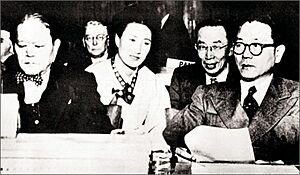
In February 1946, Chang Myon was chosen as a member of the Democratic Conference. He was also a representative for the Emergency Peoples Conference. That August, he was elected to the South Korean Provisional National Assembly. He became an important political figure in the government of Syngman Rhee.
On May 10, 1948, he was elected to the National Assembly from Seoul. On October 11, he led South Korea's group to the UN General Assembly. He saw the UN officially recognize South Korea as a country in December 1948. In 1949, he visited the Vatican to thank them for their support.
In December 1949, he became the first ambassador from South Korea to the United States. In April 1950, he was sent as a special envoy to Australia, New Zealand, and the Philippines. When the Korean War began on June 25, 1950, he quickly asked the United States and the UN for urgent help.
Prime Minister of the First Republic
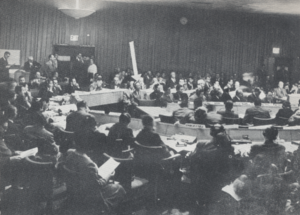
In November 1950, Chang Myon was asked to be the second Prime Minister of the First Republic of Korea. He first said no, but after Syngman Rhee strongly asked him, he accepted. He served from October 1951 to April 1952. He also went to the sixth UN General Assembly in Paris.
Chang Myon was a strong Catholic. He became a main leader of the group that opposed President Rhee in the late 1950s.
By the late 1950s, Chang Myon was seen as the main alternative to President Rhee. In 1960, student protests led to Rhee's government being overthrown. After this, Chang Myon was elected Prime Minister of the Second Republic of Korea. He became the country's main leader.
Becoming Vice President
In September 1955, he lost the chance to be the presidential candidate for the Democratic Party. Instead, he was chosen as the candidate for vice president. His running mate, Shin Ik-hee, sadly died in May 1956. On May 30, 1956, Chang Myon was elected the fourth vice president of South Korea.
On September 28, 1956, during a Democratic Party meeting in Seoul, someone tried to shoot him. He was shot in the wrist, but the attacker was caught right away. This attack was likely planned by people from the ruling Liberal Party. During his time as vice president, Chang Myon had disagreements with Lee Ki-poong, an important member of the Liberal Party. Lee Ki-poong even had spies watch Chang Myon.
In 1959, Chang Myon became a member of the Supreme Council of the Democratic Party. He was again a candidate for vice president, running with presidential candidate Cho Byong-ok. Chang Myon had wanted to be the presidential candidate but lost to Cho. In November, he was re-elected to the supreme council of the Democratic Party.
In the vice-presidential election of March 15, 1960, Chang Myon lost to Lee Ki-poong by a very large and suspicious number of votes. People protested, saying there was cheating. Thousands gathered in the city of Masan to protest. When police started shooting, protesters threw rocks. After the protests were stopped, the body of a young student, Kim Ju-yul, was found. This sad event helped start the April 19 Movement, which led to the overthrow of President Rhee's government in May 1960.
Prime Minister of the Second Republic
In May 1960, Chang Myon ran for a seat in the National Assembly. He was a leader of a group within the Democratic Party. On August 18, 1960, he was elected Prime Minister of the Second Republic of Korea. In this role, he was the country's main leader.
Because President Rhee had used his power unfairly, the Second Republic chose a parliamentary system. President Yun Bo-Seon had mostly a ceremonial role. The real power was held by Chang Myon and his cabinet.
When Syngman Rhee was forced to leave office in April 1960 due to bad government and corruption, South Korea was in a difficult situation. So, Prime Minister Chang Myon's government faced many political and economic problems. Even with these challenges, Chang Myon's government did not become a dictatorship. He had fought against Rhee's unfair rule for many years and truly believed in democracy.
His government had also created the first five-year plan for economic development. This plan would have helped all Koreans. Later, the government of Park Chung-hee used almost the same plan for economic development after the military takeover.
In 1961, Chang Myon's government tried to restart talks about a treaty with Japan to make their relationship normal. However, these talks stopped because of the military takeover led by Park Chung-hee on May 16. The Park Chung-hee government later negotiated the 1965 Treaty on Basic Relations Between Japan and the Republic of Korea.
Later Life and Passing
Chang Myon's Second Republic of Korea government was overthrown by the May 16 coup led by Major-General Park Chung-hee on May 16, 1961. On May 20, 1961, he was removed from his position as Prime Minister after less than a year in power.
On March 30, 1962, the military government held Chang Myon and stopped him from being involved in politics. At first, he was even threatened with the death penalty. But in August 1962, he was released. In 1962, he wrote about his struggles in a letter called "Why Must I Suffer?"
On January 27, 1966, Chang Myon was hospitalized with hepatitis in Seoul. He passed away on June 4, 1966, in Jongro, at the age of 66.
His Impact
Chang Myon was buried at the Hehwa Catholic Church burial site in Pocheon. On October 27, 1999, President Kim Dae-jung honored him after his death with a high award for his contributions to the nation. In August 1999, Cardinal Kim Sou-hwan held a special memorial mass for Chang Myon's 100th birthday. He questioned how the leaders of the May 16 military coup could claim Chang Myon's government was corrupt and unable to lead so soon after it began.
Family Life
Chang Myon's wife, Kim Ok-yoon, lived to be 90 years old (1901-1990). They had six sons and three daughters. Their first two children passed away when they were very young.
Their children included:
- Joseph Chang Jin, who became a biology professor.
- Benedicta Chang Yi-sook, an artist and teacher.
- Andrew Chang Geon, a successful architect.
- John Chang Yik, who became a Catholic bishop.
- Leo Chang Soon, a political science professor.
- Matthew Chang Heung, a manager at the Bank of Paris.
- Teresa Chang Myong-ja, a librarian.
Chang Myon had two younger brothers and three younger sisters. His older brother, Louis Chang Bal, was an artist and a dean at Seoul National University. His younger brother, Paul Chang Geuk, was a physics professor and space scientist at NASA. One of his sisters, Agneta Chang Jeong-eun, was a Maryknoll Sister and founded a Korean religious order in North Korea.
What He Believed In
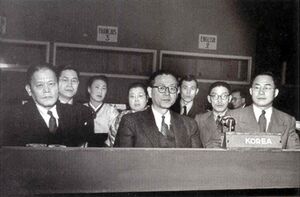
Chang Myon strongly believed in freedom and democracy. He was against communism, like that in the Soviet Union, and Nazism, like that in Germany. He also firmly opposed any form of unfair rule where one person or group has too much power.
Chang Myon believed that individuals were important, but also that people should work for the good of everyone. He disliked corruption in South Korea's politics and economy. He believed a republic should serve the public interest and common good.
Chang Myon lived a simple life. He lived in a small, modest house in Seoul where he and his wife raised their seven children. This house is now a National Heritage site and a museum dedicated to him, open to the public.
Throughout his life, he did not smoke or drink. He enjoyed listening to classical music. He also influenced Kim Dae-jung to become Catholic and became his godfather. Kim Dae-jung later said that Chang Myon was a "devout Catholic who believed in Catholic action to fix many problems in Korea."
See Also
 In Spanish: Chang Myon para niños
In Spanish: Chang Myon para niños
- Democratic Party of Korea
- Park Chung-hee
- Syngman Rhee
- Yun Bo-Seon
- Yun Chi-ho
- Yun Chi-Young
- Jang Jun-ha
- Kim Dae-jung
- Heo Jeong


